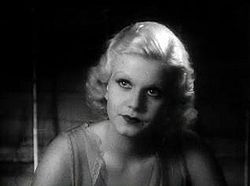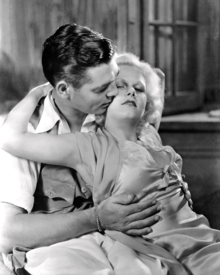
William Clark Gable was an American film actor. Often referred to as the "King of Hollywood", he had roles in more than 60 films in a variety of genres during a career that lasted 37 years, three decades of which was as a leading man. He was named the seventh greatest male movie star of classic American cinema by the American Film Institute.
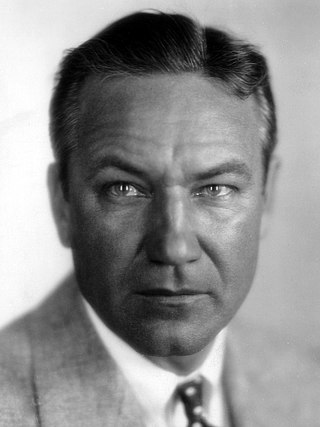
Victor Lonzo Fleming was an American film director, cinematographer, and producer. His most popular films were Gone with the Wind, for which he won an Academy Award for Best Director, and The Wizard of Oz. Fleming has those same two films listed in the top 10 of the American Film Institute's 2007 AFI's 100 Years...100 Movies list.
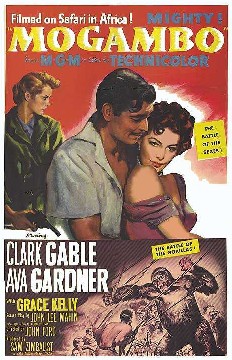
Mogambo is a 1953 Technicolor adventure/romantic drama film directed by John Ford and starring Clark Gable, Ava Gardner, and Grace Kelly, and featuring Donald Sinden. Shot on location in Equatorial Africa, with a musical soundtrack consisting entirely of actual African tribal music recorded in the Congo, the film was adapted by John Lee Mahin from the play Red Dust by Wilson Collison. The picture is a remake of Red Dust (1932), which was set in Vietnam and also starred Gable in the same role.

Jean Harlow was an American actress. Known for her portrayal of "bad girl" characters, she was the leading sex symbol of the early 1930s and one of the defining figures of the pre-Code era of American cinema. Often nicknamed the "Blonde Bombshell" and the "Platinum Blonde", Harlow was popular for her "Laughing Vamp" screen persona. Harlow was in the film industry for only nine years, but she became one of Hollywood's biggest movie stars, whose image in the public eye has endured. In 1999, the American Film Institute ranked Harlow number 22 on its greatest female screen legends list.
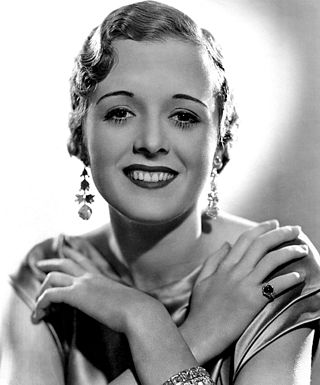
Mary Astor was an American actress. Although her career spanned several decades, she may be best remembered for her performance as Brigid O'Shaughnessy in The Maltese Falcon (1941).

Green Fire is a 1954 American CinemaScope and Eastmancolor adventure drama film released by Metro-Goldwyn-Mayer. It was directed by Andrew Marton and produced by Armand Deutsch, with original music by Miklós Rózsa. The picture stars Grace Kelly, Stewart Granger, Paul Douglas and John Ericson.
John Lee Mahin was an American screenwriter and producer of films who was active in Hollywood from the 1930s to the 1960s. He was known as the favorite writer of Clark Gable and Victor Fleming. In the words of one profile, he had "a flair for rousing adventure material, and at the same time he wrote some of the raciest and most sophisticated sexual comedies of that period."

Red-Headed Woman is a 1932 American pre-Code romantic comedy film, produced by Metro-Goldwyn-Mayer, based on the 1931 novel of the same name by Katharine Brush, and a screenplay by Anita Loos. It was directed by Jack Conway and stars Jean Harlow as a woman who uses sex to advance her social position. During the course of the film, Harlow's character breaks up a marriage, has multiple affairs, has premarital sex, and attempts to kill a man.

Wife vs. Secretary is a 1936 American romantic comedy drama film starring Clark Gable, Myrna Loy and Jean Harlow. Directed and co-produced by Clarence Brown, it was the fifth of six collaborations between Gable and Harlow and the fourth of seven between Gable and Loy. The screenplay was based on the short story of the same title by Faith Baldwin, published in Cosmopolitan magazine in May 1935. The screenplay was written by Norman Krasna, John Lee Mahin and Alice Duer Miller.
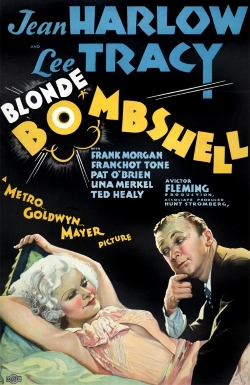
Bombshell is a 1933 American pre-Code romantic screwball comedy film directed by Victor Fleming and starring Jean Harlow, Lee Tracy, Frank Morgan, C. Aubrey Smith, Mary Forbes and Franchot Tone. It is based on the unproduced play of the same name by Caroline Francke and Mack Crane, and was adapted for the screen by John Lee Mahin and Jules Furthman.

Hugh Ryan "Jack" Conway was an American film director and film producer, as well as an actor of many films in the first half of the 20th century.
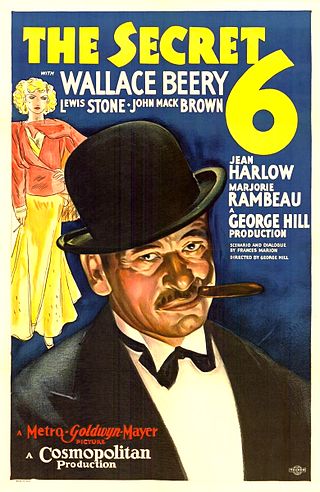
The Secret Six is a 1931 American pre-Code crime film starring Wallace Beery as "Slaughterhouse Scorpio", a character very loosely based on Al Capone, and featuring Lewis Stone, John Mack Brown, Jean Harlow, Clark Gable, Marjorie Rambeau and Ralph Bellamy. The film was written by Frances Marion and directed by George W. Hill for MGM.
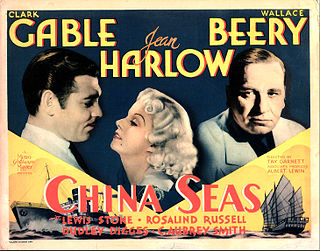
China Seas is a 1935 American adventure film starring Clark Gable as a brave sea captain, Jean Harlow as his brassy paramour, and Wallace Beery as a suspect character. The oceangoing epic also features Rosalind Russell, Lewis Stone, Akim Tamiroff, and Hattie McDaniel, while humorist Robert Benchley memorably portrays a character reeling drunk from one end of the film to the other.

Saratoga is a 1937 American romantic comedy film starring Clark Gable and Jean Harlow and directed by Jack Conway. The screenplay was written by Anita Loos. Lionel Barrymore, Frank Morgan, Walter Pidgeon, and Una Merkel appear as featured players; Hattie McDaniel and Margaret Hamilton appear in support. It was the sixth and final film collaboration of Gable and Harlow.

Hold Your Man is a 1933 American pre-Code romantic drama film directed by an uncredited Sam Wood and starring Jean Harlow and Clark Gable, the third of their six films together. The screenplay by Anita Loos and Howard Emmett Rogers was based on a story by Loos.
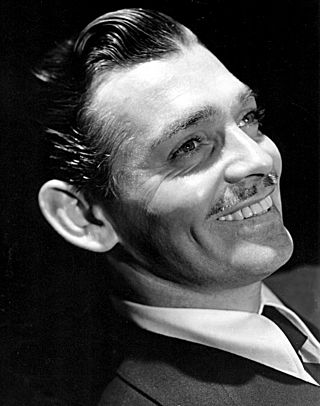
Clark Gable (1901–1960) was an American actor and producer who appeared in over 70 feature films and several short films. Gable first began acting in stage productions, before his film debut in 1924. After many minor roles, Gable landed a leading role in 1931, subsequently becoming one of the most dominant leading men in Hollywood. He often acted alongside re-occurring leading ladies: six films with Jean Harlow, seven with Myrna Loy, and eight with Joan Crawford, among many others.

Honky Tonk is a 1941 American historical western comedy drama film directed by Jack Conway and starring Clark Gable and Lana Turner. The supporting cast features Claire Trevor, Frank Morgan, Marjorie Main, Albert Dekker and Chill Wills. Produced by Pandro S. Berman, the film was made and distributed by Metro-Goldwyn-Mayer.
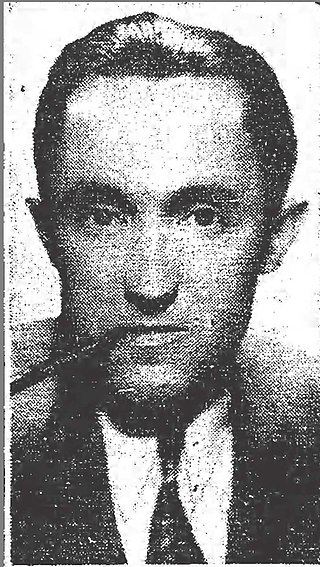
Wilson Collison was a writer and playwright.

Jean Harlow was an American actress who made her uncredited debut in two 1928 films: Honor Bound for Fox Film; and Moran of the Marines for Paramount Pictures. While waiting for a friend at the studio in 1928, she was discovered by studio executives who gave her letters of introduction to casting agencies, where she was offered the two small roles that subsequently launched her film career. During the initial two years of her career, Harlow appeared uncredited in 16 films, including several Hal Roach productions developed for Laurel and Hardy. Her first speaking role was a bit part in the 1929 American pre-Code romantic comedy The Saturday Night Kid, starring Clara Bow and Jean Arthur. The film has since been preserved by the UCLA Film and Television Archive.

Train Ride to Hollywood is a 1975 American comedy/fantasy pop musical directed by Charles R. Rondeau and starring the Kansas City R&B group Bloodstone.


